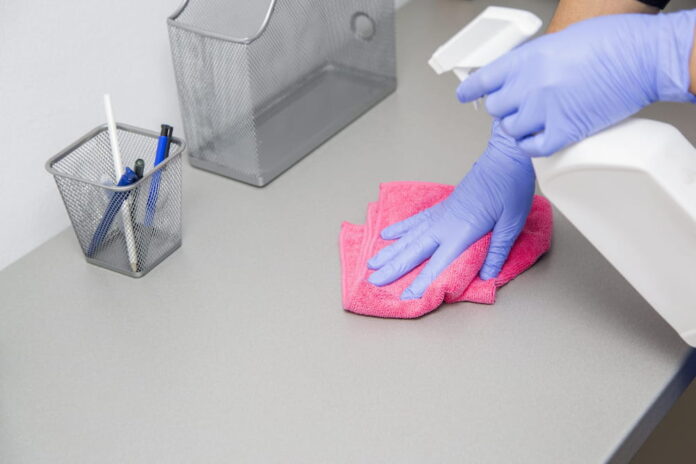Picture this: a world where doorknobs, elevator buttons, and even shopping carts sanitize themselves, rendering infections extinct. This is no longer a pipe dream, thanks to the emergence of innovative technologies that are being integrated into everyday objects. Built-in germ-fighting solutions are revolutionizing the way we interact with our surroundings, offering a safer and healthier environment for everyone.
Even though germs cannot be seen without a microscope, they still exist in our surroundings. They are commonly found on surfaces that people touch regularly with their hands (like handrails, door handles, furniture in cafes and so on), called “high-touch surfaces”. This mode of transmission through hand contact can significantly contribute to the dissemination of viruses like the flu, covid or others, and even mpox (previously known as monkeypox), for which WHO recently declared a public health emergency.
Numerous conversations about the dangers of infection, which have intensified during the Covid pandemic, have led to increased public concern and, in some cases, panic fear of infection among people around the world. It turned out that even health professionals couldn’t escape the panic: a recent study showed that the Covid Anxiety Syndrome induced post-traumatic stress disorder, fear of COVID, and depression in front-line healthcare workers. This highlights the critical role that high-touch surfaces play in the spread of infectious diseases, and underscores the significance of their proper disinfection for public health.
To solve the problem, some public cleaning providers conventionally resort to traditional wipes, cleaning agents and disinfectants, but a closer look shows that it’s more of a cookie-cutter solution when it comes to high-touch areas. The problem is that high-touch surfaces have to be cleaned and disinfected regularly to maintain a hygienic environment, which can be time-consuming and labor-intensive, especially in public spaces.
In addition, the job can be subject to human error, such as using the wrong cleaning products, not following proper application procedures, or failing to clean all surfaces thoroughly. This compromises the effectiveness of the cleaning process, negates the efforts made – and forces us to think of other ways to work out the issue.
Wrap-up disinfectants
If traditional cleaning methods are not effective enough, why not invent a surface hostile to pathogens? This is the logic behind today’s innovative solutions that are said to provide effective and long-lasting barriers against the spread of germs on high-touch surfaces, offer additional protection for all users and minimize risks of contracting an infectious disease: “If we can improve our ability to remove contamination, we should mitigate that risk,” says Dr Jon Otter, an epidemiologist focused on Infection Prevention and Control at Imperial College London.
There are many scientists working on the problem around the world right now, and some of them offer quite original solutions. Here’s, for instance, Sharklet by the US company Sharklet Technologies Inc., which mimics shark skin patterns to prevent harmful bacteria and biofilms. The material consists of a well-organized arrangement of bars in an interlocking diamond pattern that forms a surface preventing microorganisms from adhering and multiplying on it: “Sharklet surface technology basically creates a surface that inhibits bacterial adhesion and growth by limiting the organism from touching the surface through minimizing the available water required,” explains Anthony Brennan, Chief Technology Officer and Chairperson of the company.
The materials that are made anti-pathogen from the start are mostly designed to replace the original surface, and so they come in the form of adhesively backed plastic wraps applied to elevator buttons, grab handles, desks and other high-touch areas. Some of them, such as Sharklet, work based on a specific structure that inhibits the growth of bacterial colonies and biofilm formation, but does not kill viruses. Other wrap-up technologies utilize the properties of certain chemicals and metals to have a more complete effect, like copper-based anti-pathogen adhesive wraps by CuGrip, a company from Canada: “Copper’s mission in life is to move electrons,” says Michael Schmidt, microbiologist and immunologist at the Medical University of South Carolina. “And when it encounters oxygen, it’ll give the oxygen another electron, effectively creating mini-lightning at that surface. It literally blows the virus to smithereens.”
For all their variety of actions, however, such films have several significant disadvantages. First, almost all of them are made on the basis of plastic, which raises environmental concerns (for example, a metal handrail wrapped in such a film will require additional work before sending the item to the landfill).
Second, the very nature of the technology, namely wrapping, makes it impossible to use it on surfaces with recesses and protrusions and on objects of non-standard shapes: “You can’t expect a self-adhesive copper wrap to fit perfectly on every high-touch surface,” says a user of the wrap.
These seemingly small disadvantages turn into significant obstacles when applied to the real world. First of all, they affect the acceptance of such technologies by businesses and authorities: the cost of the films themselves and their installation add up to a rather impressive sum, and non-standard shapes and surfaces create the risk of abrasion and tearing.
Meanwhile, continuing health hazards are on the rise and the public is beginning to show increased preference in safety: the surface disinfectants market size is projected to grow at 7.3% CAGR from 2024 to 2032, with the surging demand for eco-friendly and non-toxic disinfectants, spurred by heightened consumer awareness regarding environmental and health issues. Could there be another solution to meet all these needs?
Anti-pathogen coatings
To fully comply with the trends and demands and to ensure complete protection, companies and public healthcare providers are now opting to use anti-pathogen varnishes and coatings. These can be incorporated into objects during the production phase or applied to an existing surface, allowing for complete coverage and protection according to the material used, says Henri Rosset, Research Center Manager of Bioguard, a French anti-pathogen technology developed by Bioguard & Co, a subsidiary of the French Oberthur Fiduciaire Group, one of the world leaders in banknote printing: “We adjust the dosages according to the surface that needs to be treated…We have developed coatings/varnishes that can be used on all types of materials.” This solution has been successfully tested for years, as it is found on billions of banknotes printed by Oberthur Fiduciaire that circulate from hand to hand every day around the world.
Bioguard was originally devised in the wake of the avian flu crisis, and was used only in the production of banknotes at first. Over time, the solution passed the wear-and-tear and ageing tests, and proved that it remains safe for people and environment, does not affect the recyclability of objects and works against bacteria, viruses, and fungi, with lab tests proving that Bioguard is highly effective against coronaviruses. This allowed the company to extend the technology for different uses, from wallpapers and furniture to touchscreens, self-checkouts and other high-touch areas to help its users ensure better cleanliness and protection.
Like the wrap-up technologies, such solutions have different bases: they can use synthetic antibacterial agents like triclosan, various metals (such as silver in Bioguard, which makes it effective against different kinds of viruses, fungi and bacteria), and even nanoparticles, as in the antimicrobial coating Vetro +, designed exclusively for flat glass: “We use the common glass found in the windows of any house and we add an antimicrobial film or paint that fuses with the glass above 600 degrees Celsius”, tells Christian Aguilar, founder of Vetro + producer company Materiales Avanzados.
By and large, the trend for public safety is visible enough and comes from growing demand from both consumers and those responsible for public healthcare. Some of them may still have doubts related to effectiveness, cost, and potential long-term impacts of anti-pathogen solutions for high-touch surfaces, but as they become more widespread and operators start to engage with producers and the public, the acceptance is likely to increase and our daily environment is likely to become safer.
Did you find this helpful? Check out our other helpful articles on our website.
Read Also
- Ketamine-Assisted Therapies: Impacts on Employee WellbeingWorkplace stress is common today. Many employees feel tired, anxious, or burned out. Regular therapy can help, but some people need more support. Ketamine-assisted therapy is showing good results for mental health. A ketamine-assisted therapist guides each session safely. This therapy can improve mood, focus, and energy. Learning more about it can help teams stay… Read more: Ketamine-Assisted Therapies: Impacts on Employee Wellbeing
- The Future of Men’s Health: Why Telehealth Is Here to StayTelehealth isn’t just a pandemic trend that faded into the background. For Australian men, it has become one of the most practical, time-saving, and stress-free ways to manage everyday health — and it’s shaping the future of how we access care. Platforms like DOCTO, an Australian online doctor and specialist telehealth service, are leading the… Read more: The Future of Men’s Health: Why Telehealth Is Here to Stay
- How to Build a Simple, Clean Skincare Routine ?You don’t need a complicated skincare routine. It doesn’t have to be something that requires twenty different products and confusing steps. Your routine works well with just a few high-quality clean ingredients. The beauty industry keeps pushing more products, but your skin actually needs less. You only need a simple approach to get better results… Read more: How to Build a Simple, Clean Skincare Routine ?
- How Preventive Dental Care Supports Overall HealthHave you ever wondered how a simple dental checkup could impact your entire body? Oral health is more than just a bright smile. Studies show that poor dental habits can contribute to serious health problems. Gum disease and tooth decay are linked to heart disease, diabetes, and infections. Yet, many people overlook preventive dental care.… Read more: How Preventive Dental Care Supports Overall Health
- Seeing Clearly in a High-Tech World: A Deep Dive into Advanced Vision Care ServicesProtecting your eyesight isn’t optional—it’s essential. Modern eye care has evolved far beyond basic exams, offering advanced diagnostics, personalized treatments, and surgical innovations that keep vision sharp for life. A leading example is Intermountain Eye Center, home to specialists like Dr Fishburn Boise, where patients receive comprehensive, high-level vision care designed to preserve long-term eye… Read more: Seeing Clearly in a High-Tech World: A Deep Dive into Advanced Vision Care Services
- Why the Keto Diet Works for Some People—and Fails Dramatically for Others: An Ayurvedic Breakdown for Modern HealthcareThe keto diet has dominated weight-loss culture for years. For some people, it produces rapid fat loss, stable energy, and improved mental clarity. For others—especially those who gain weight easily—it leads to burnout, digestive distress, rebound weight gain, high cholesterol, and a metabolism that feels slower than before. Healthcare often frames this as a discipline… Read more: Why the Keto Diet Works for Some People—and Fails Dramatically for Others: An Ayurvedic Breakdown for Modern Healthcare
- How to Choose the Best Assisted Living Facility for SeniorsAre you looking for the right assisted living facility for a senior loved one? Choosing a place can feel overwhelming. There are many factors to consider, from care services to the environment. Safety, comfort, and social opportunities play important roles in daily life. Each senior has unique needs and preferences that must be met. Understanding… Read more: How to Choose the Best Assisted Living Facility for Seniors
- Burn Smart, Not Hard; Shape Burn: Clean Protein for Weight ManagementYou want to feel light, strong, and confident. You don’t want crash diets or fake promises. You need a plan that works with your body, not against it. That’s where Shape Burn comes in. You can burn fat without losing strength. You can eat better and stay full. You can manage weight in a way… Read more: Burn Smart, Not Hard; Shape Burn: Clean Protein for Weight Management









